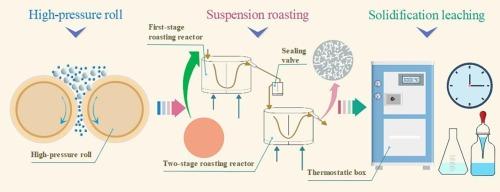Semi-industrial test of vanadium extraction from stone coal vanadium ore by high-pressure roll-suspension roasting-solidification leaching process
IF 5
2区 工程技术
Q1 ENGINEERING, CHEMICAL
引用次数: 0
Abstract
Rich vanadium resources are stored in stone coal. Compared with the high temperature, high pressure, and high acid concentration conditions required by the direct leaching process, the roasting-leaching process demonstrates significant advantages. Roasting liberates and oxidizes the vanadium in the ore, allowing it to be recovered through a subsequent leaching process. This approach not only reduces the severity of the operating conditions but also broadens the application scope. The high-pressure roll-suspension roasting-solidification leaching process has been proposed to enhance vanadium leaching. Semi-industrial test results showed that qualified feed was obtained under the feed rate of 50 kg, the feed particle size of −15 mm, the roller surface pressure of 13–14 MPa, and the roller speed of 18 r/min. The suspension roasting system achieved stable and effective operation under the processing capacity of 90 kg/h, the air consumption of 28.0 m3/h, the CO2 consumption of 8.0 m3/h, and the temperature of ≥ 890 °C in the primary and secondary reactors. Under the acid mixing temperature of 130 °C, acid dosage of 40 %, curing time of 6 h, and leaching time of 3 h, the V2O5 leaching rate of 83.79 % was obtained. After roasting, the cracks of the ore increase and elongate, the micropores enlarge and transform into open internal pores, the surface roughness of the ore undergoes further changes.

高压滚悬焙烧—凝固浸出法从石煤钒矿石中提钒半工业试验
石煤中蕴藏着丰富的钒资源。与直接浸出工艺所需的高温、高压、高酸浓度条件相比,焙烧浸出工艺具有明显的优势。焙烧释放并氧化矿石中的钒,使其通过随后的浸出过程得以回收。这种方法不仅降低了操作条件的严峻性,而且拓宽了应用范围。为提高钒浸出率,提出了高压悬滚焙烧-凝固浸出工艺。半工业试验结果表明,在进料量为50 kg,进料粒度为- 15 mm,辊面压力为13-14 MPa,辊速为18 r/min的条件下,可获得合格的进料。悬浮焙烧系统在处理量90 kg/h、耗风量28.0 m3/h、CO2耗气量8.0 m3/h、主、二次反应器温度≥890℃条件下稳定有效运行。在混酸温度为130℃、酸用量为40%、固化时间为6 h、浸出时间为3 h的条件下,V2O5的浸出率为83.79%。焙烧后,矿石的裂纹增加并拉长,微孔扩大并转变为开口的内孔,矿石的表面粗糙度进一步发生变化。
本文章由计算机程序翻译,如有差异,请以英文原文为准。
求助全文
约1分钟内获得全文
求助全文
来源期刊

Minerals Engineering
工程技术-工程:化工
CiteScore
8.70
自引率
18.80%
发文量
519
审稿时长
81 days
期刊介绍:
The purpose of the journal is to provide for the rapid publication of topical papers featuring the latest developments in the allied fields of mineral processing and extractive metallurgy. Its wide ranging coverage of research and practical (operating) topics includes physical separation methods, such as comminution, flotation concentration and dewatering, chemical methods such as bio-, hydro-, and electro-metallurgy, analytical techniques, process control, simulation and instrumentation, and mineralogical aspects of processing. Environmental issues, particularly those pertaining to sustainable development, will also be strongly covered.
 求助内容:
求助内容: 应助结果提醒方式:
应助结果提醒方式:


